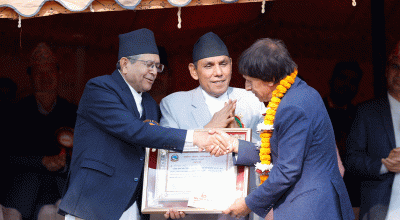
KATHMANDU: Although the government has started safe abortion service at the door steps, the practice of abortion using non-prescription medicine has not stopped yet.
The practice of undergoing abortion using unauthorized medicine without guidance of skilled health workers has also put women’s life at risk and some of women lose their lives untimely due to use of such non-prescription drugs.
Kathmandu Valley Chapter Manager of Family Planning Association of Nepal (FPAN), Sharad Aryal, said, “The trend of having an abortion using unauthorized medicine without advice of skilled health workers has not been stopped yet. The number of people visiting the health institutions in critical stage of health complication due to this has not decreased.”
The government bodies do not have exact data on how many women in the country need safe abortion service and how many women get abortion service using medicines from pharmacies.
Many service recipients are still dependent on the pharmacies in lack of information about such hospitals providing safe abortion service and safe abortion service at their door steps.
The FPAN has been providing safe abortion service to those in need through its clinic by mobilizing reproductive health volunteers to end unsafe abortion.
Aryal shared, “We have been providing abortion service though both clinic and medication under safe abortion service.”
Home-visit service failed to turn effective Home visit service for safe abortion and family management has failed to become effective in absence of dissemination of required information and proper public awareness.
The government had launched the service targeting those population unable to visit health institutions or having no access to such facilities due to various reasons, people with physical disabilities and marginalized community.
The need of service was highly realized during COVID-19 pandemic and it aimed to continue with reproductive, maternity, neonatal and child health services during the crisis.
The service was expected to be helpful in increasing people’s access to means of family planning, keeping safe abortion service continued.
The Ministry of Health and Population has incorporated the service in Safe Abortion Programme Management Directive, 2078 BS as well.
The government had launched the telephone consultation and home-visit services in those areas by issuing the ‘COVID-19 pandemic: reproductive, maternity, neonatal and child health service interim directive, 2077 BS’ in April-May 2020.
The Family Welfare Division, Department of Public Health Services said the service is in force at the moment, too. But official data of beneficiaries of the service so far is still missing.
It is said the target groups need to be more aware of the availability of the service. During pandemic, the use of the means of family planning has dropped to 37 from 39 percent.
According to the World Health Organisation, a two-year spacing in pregnancy by the use of the contraceptive methods is crucial for reducing infant and maternal maternity rate as it could contribute to downsize the figures by 10 and 30 percent respectively.
The expansion of the use of family planning service is considered mandatory to reduce child and maternal maternity rate.
The Nepal Health Sector Strategy ( 2016-2021) had an ambitious target of reducing the maternal maternity rate to 125 per 100,000 live births an while the Sustainable Development Goals ( SDGs) set goals of reducing neonatal and child mortality rate (below five) to 12 and 20 respectively 2030.
The achievements of the goals seem almost impossible.
The present situation suggests the need to promote advanced contraceptive methods and increase investment in maternity and neonatal caring to see better results.
In Nepal, only around 64 percent expectant mothers make four visits as recommended by the WHO for antenatal care and only 61 percent births are attended by skilled health workers.
According to a study, less than 50 percent of health institutions in Nepal provide family planning services.
The National Demographic Health Survey 2016 shows that in Nepal 53 percent married women aged 15-49 use the contraceptive methods and of them, 43 percent use modern methods and 10 percent opt for traditional methods.
The survey reveals that a more number of contraceptive users (52 percent) is from the relatively less educated or formally not educated community than well-educated families who make up 34 percent.
A significant improvement in the use of contractive and family planning service among married women is still awaited in Nepal and its users presently make up 53 percent against 29 in 1996.
Assistant director Dr Puri underlined the need of promoting the use of modern contraceptive measures and access of safe abortion facility to improve child and maternal health care results.












